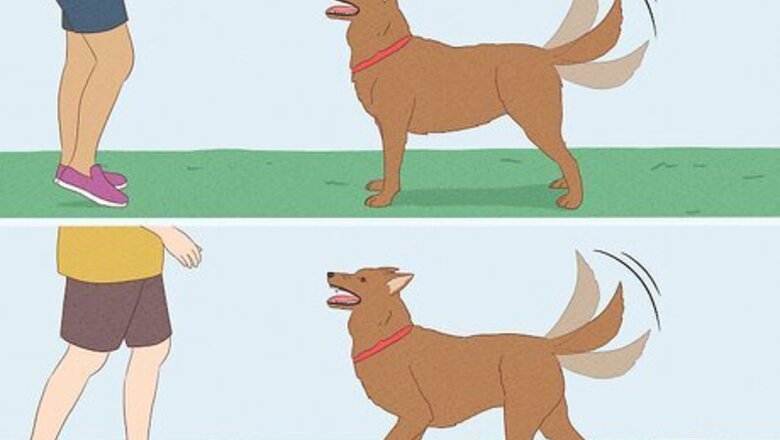
views
Dog Tail Wagging Interpretation
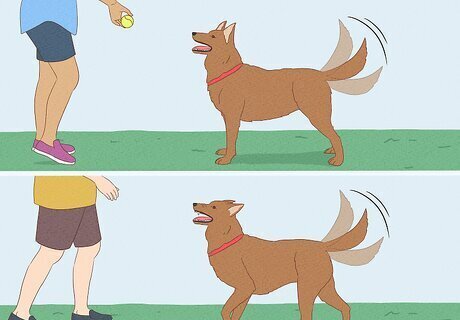
Tail high and wagging fast—extreme emotion This is called “flagging” and it’s a very important phenomenon for dogs when it comes to communicating. If their tail is pointing up to the sky (or even slightly curled over their back) and wagging rapidly, they’re flagging. This is basically the “I’m extremely aroused” tail wag. It could mean “I’m excited to play,” “I’m extremely stressed,” “I’m happy to see you,” or “I’m ready to fight.” How do you know if they’re happy or upset? With flagging, you have to look at the ears and posture. If the dog’s ears are relaxed and they’re doing the “I want to play” bow, they’re happy. If their ears are tucked back, they’re growling, and they’re either backing up or coming at you, they’re stressed or ready to fight. Don’t try to calm down an aggressive and active dog. Feichtner explains, “You don't want to start petting the dog to calm them down. That's not going to work.” Instead, simply remove them from the situation or seek help if it’s not your dog.

Tail high and moving slowly—cautious anxiety This is called “slow flagging” and it’s less ambiguous than the faster variant. When a dog’s tail is pointed straight up and it’s moving slowly back and forth, the dog is typically a little tense or concerned. Occasionally, dogs will do this if they’re happy but a little confused by how to act, or if they’re meeting a dog and they want to play but the other dog isn’t reciprocating. If your dog has their tail high while gently wagging it, try giving them a little direction or feedback. You might say, “It’s okay! Go play!” if they’re investigating a dog park, or “Don’t worry” and gently pet them if there’s a thunderstorm.
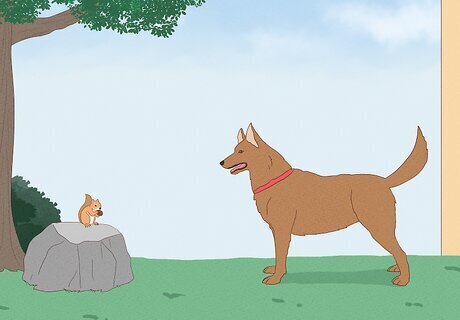
Tail high and still—alert and on guard Dogs with their tail pointed straight up and stiff are focused. They may be super tense and trying to pay attention to see what they should do next, or they could simply be focused on a squirrel they see moving in the distance. The takeaway here is that they’re on guard, so don’t mess with a dog in this state of arousal. Hunting dogs and guard dogs will take this posture more often than a lot of other breeds. Dogs often do this when looking at the window. It’s just a sign they probably want to chase whatever they’re looking at. If your dog shouldn’t be on alert, correct them. Feichtner says, “It's totally okay to say no to your dog and to correct the behavior that you don't want to see.” Distract your dog momentarily and give them a treat whenever they relax.
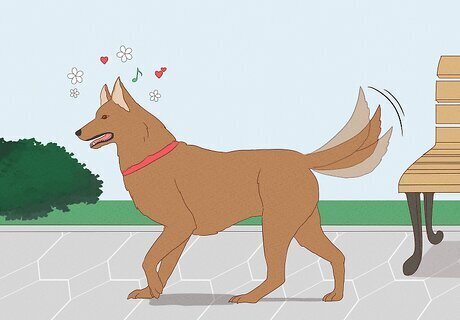
Medium-height tail wag—gentle and pleasant arousal Dogs with a gentle, medium-height tail wag are chilling. They’re relaxed and not especially aroused. Dogs with this wag can still bite if they’re bothered or messed with, but they’re decidedly not looking for a fight with their tail in this position. The speed of the wag matters a lot here. With a medium-height wag, a slow, deliberate wag indicates more concern or passive “don’t mess with me” energy. A faster wag is normally a sign they’re happy and ready to play.

Circular tail wag—excitement for something special This is a relatively rare tail maneuver and not all dogs will do it (it looks like some breeds never do it), but dogs typically save the big circular wag for when they’re really happy and amped. Usually, you’ll see dogs do this when they see their owner after a long absence or if they see their best dog friend at the park. Dogs may also do this wag if you’re holding their favorite treat or if they’re on the way to a dog park or favorite location.

Straight out and stiff—prepping a “fight, flight, or relax” response Unless you’re looking at a pointer breed that will use their tail to direct hunters toward a target, the “straight and stiff” look (where the tail is parallel to the spine) is a sign of serious tension. This is the position where a dog’s tail is most neutral, meaning it can move in any direction with an equal amount of effort, so dogs will typically take this posture when they think they’re on the edge of a big decision. In other words, they aren’t sure if they’re about to fight, about to run away, or about to learn more information about why they should chill out. Dogs will often do this when they meet a new person or dog. Is the dog advancing towards another dog? This has a slightly different meaning. If their tail is straight and stiff but they’re actively advancing towards another dog, they’re expressing confidence. Basically, they’re saying, “I’m in charge, here.”

Curled up underneath—scared and submissive Dogs who curl up their tail beneath their butt are scared. They may be in pain that’s causing them to be nervous, or there may be something confusing and overwhelming going on that they can’t interpret (like a thunderstorm). Dogs will also do this if they’re super scared of a potential threat. Why do they hide their tail when they’re scared? Dogs are trying to make themselves smaller. It’s a way of hiding and telling the world, “I’m not a threat.” What should I do if my dog curls their tail like this? If it’s clear what they’re scared of, try to soothe them and get them to relax by petting them or giving them treats. If they’re scared consistently (or for odd reasons), take them to a vet. This could be a sign of a serious medical issue. Crate-train your dog if they get nervous a lot. Feichtner explains that “crates are a great tool that give a dog lots of structure and keeps them safe. Dogs are den animals. So if you introduce it right, they will gravitate towards the crate and feel quite happy in it.”
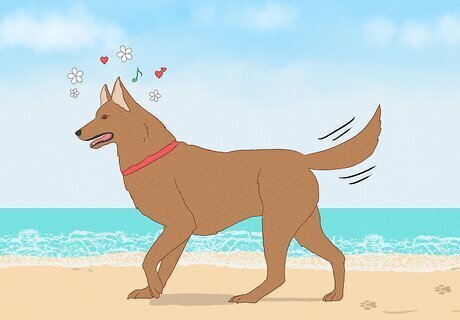
Gently moving and flowing freely—laid back and relaxed If a dog’s tail is sort of calmly rocking behind them whenever they move, it’s a sign they’re in a totally neutral and calm state. They have zero tension in their tail, so they’re basically not aroused at all.
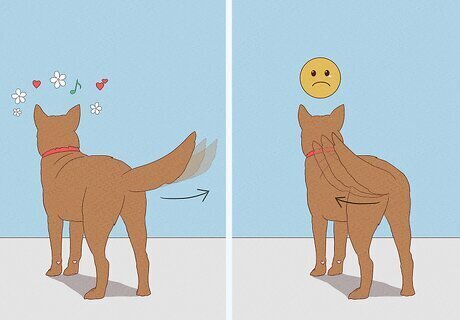
Wagging mainly (or only) to the right or left—happy or sad There is some preliminary evidence (and a few scientific studies) that suggests the direction a dog wags its tail actually reflects what part of their brain is activated at a given time. This can supposedly indicate whether a dog is expressing positive or negative emotions. Wagging to the right—happy. A tail that’s wagging more to the right than to the left seems to indicate positive arousal. So, a dog may wag to the right if they see their owner or spot a squirrel they want to chase. Wagging to the left—sad. A mainly left-sided wag may mean the dog is experiencing negative emotions. You might see a dog wag their tail to the left if they spot a scary dog or if there’s a loud bang that spooks them in the middle of a fun walk.

No wagging—old age, tiredness, or extreme relaxation You may notice your dog occasionally doesn’t wag their tail at all. This is common if they’re tired and they don’t want to spend the extra energy communicating with others. It’s also common for older dogs to not wag their tail more often (especially when they’re relaxed). Did your dog suddenly stop wagging their tail at all? This is typically a sign of a condition known as acute caudal myopathy, or “limber tail.” It’s a non-threatening injury, but you do need to see a vet (it’s usually a painful condition for dogs).
Why do dogs use their tail to communicate?
We’re not totally sure, but it’s probably our fault. Wolves do not seem to wag their tails with anywhere near the frequency that most dog breeds do, which means human beings probably bred dogs for this trait when early humans started domesticating dogs 40,000 years ago. Why did humans breed for tail wagging? We don’t know, but the odds appear to be good that dogs who were more expressive (i.e. moved their tail more often) were better at doing their job. A very communicative and responsive dog is likely a better watchdog or sheep herder than a dog who never shows how they’re feeling. Dogs also use their ears, mouth, and posture to talk! Tail wagging is not the only way dogs communicate. They also use barks, ear movements, and posture to tell other dogs how they’re feeling, so it’s not like they only talk with their tail.
What does the speed of a tail wag mean?
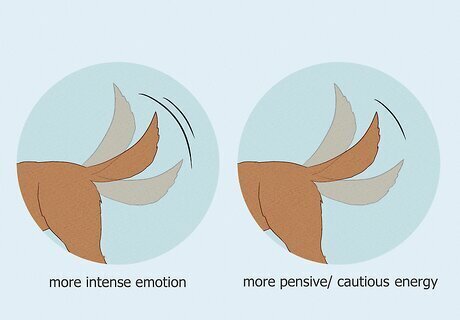
The speed of the wag generally indicates the intensity of the emotion. Every dog is different, and one dog’s “I’m super excited” can look like another dog’s “I’m terrified,” but as a rule of thumb, the faster the tail is wagging, the more intense the dog’s emotion is. A slower tail indicates a more pensive or cautious energy, while a faster tail wag can mean they’re extremely ready to play or fight. The speed of the wag alone can’t actually tell you that much. You also need to account for the direction of the wag and the angle of the tail. You need all three data points to get a good read on what a dog is probably feeling.
Can tailless dogs communicate?
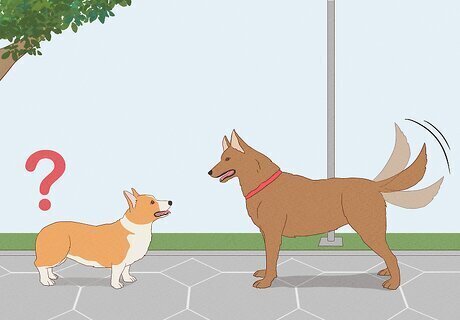
Dogs with short or missing tails do struggle to communicate. Dogs that have been bred to have shorter tails (or basically no tails at all) are at a bit of a conversational disadvantage when it comes to talking to other dogs. This means that breeds like bulldogs, pugs, rottweilers, corgis, Boston terriers, and Australian shepherds often can’t tell other dogs exactly how they’re feeling, which can lead to some misunderstandings and snafus at the dog park. Breeds with distinct ears also have this problem. After the tail, a dog’s ears are probably their most important communication tool. If a dog’s ears have been bred to sit straight (Doberman, French bulldog, corgi, etc.) or permanently lie down (basset hounds, King Charles spaniels, golden retrievers, etc.), they are similarly misunderstood by other dogs.










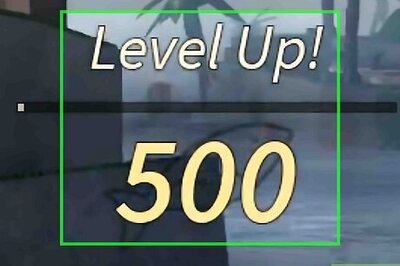


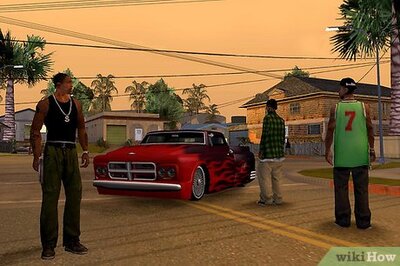


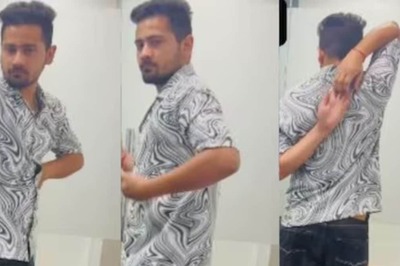
Comments
0 comment